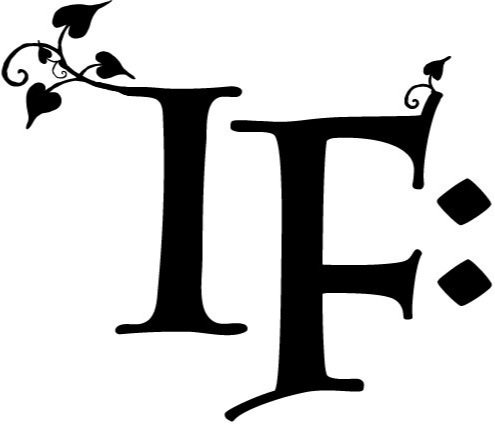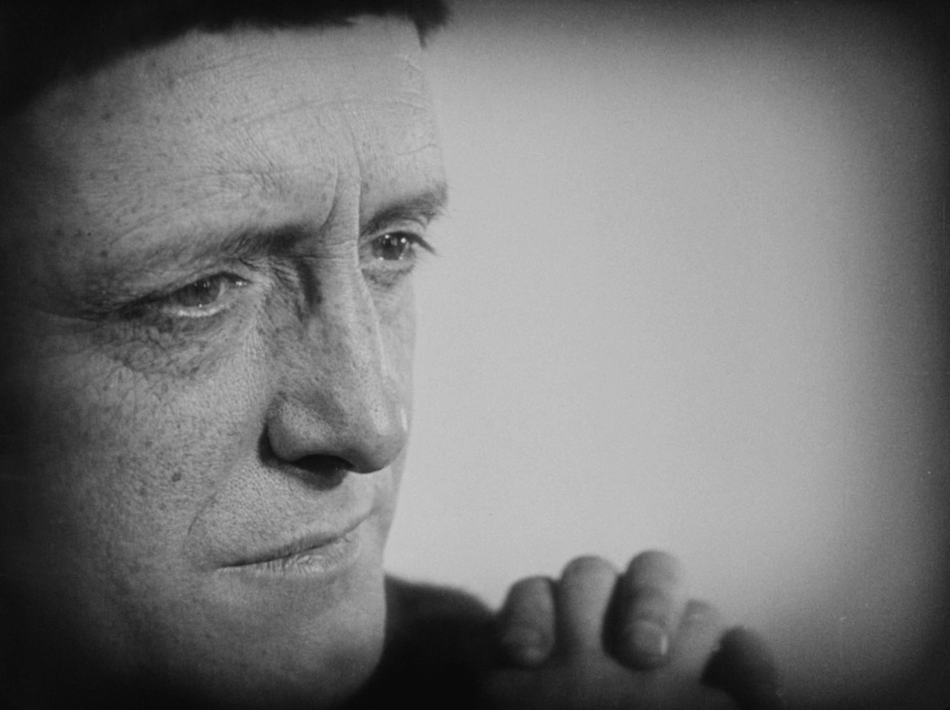The Passion of Joan of Arc
a collection of thoughts & reviews
NATHAN GILMORE: Who has not seen that face? Who, having once seen it, can ever forget it? Yet the movie opens, not with the face or with religious imagery, but with the paper records of the trial. We feel that this is a movie that intends to tell the truth, that we can trust it to tell us the facts of the story.
Soon enough, however, there is the face— Maria Falconetti’s face. We see her first as she registers fear. Her eyes are large and liquid, unblinking, only narrowing in pain or widening in fear.
There are other faces too. The chief inquisitor, stern, warted like a toad, brows permanently curled into a scowl. A friar, smirking, smug and corpulent. One pockmarked, narrow-eyed man who looks at Joan and sees something more.
The faces slink into and out of frame, most often in extreme closeups. Joan herself almost never moves her face. Her emotions are reflected in her eyes, downcast with pain or widened in ecstatic vision. The two modes are at constant war with each other. Once she breaks and sobs like the young girl that she is— but just as soon, she is gazing heavenward.
Consider the section (there are few realized “scenes” in this movie) where the inquisition asks “So you are certain of going to heaven?” The question is a trap, cornering Joan into a declaration of belief in salvation outside the Church. The struggle on Joan’s face rages. Fear, confusion, helplessness— and it melts away. Her answers do not matter, because she is certain of her inner convictions. Her answers are true only to herself and to God.
The burning at the stake is almost a catharsis. It is not the test; the inquisition was the test. The obvious and facile way to end the movie would have been with another closeup on Falconetti’s face. Dreyer doesn’t do that. The face is with us, burned into our memories. The face speaks, silently, for itself.
Nathan Gilmore was born in the Northwest Frontier Province of Peshawar, Pakistan. Now based in Franklin, Tennessee, he reads constantly and writes occasionally. Favorite authors include Milton, Steinbeck, and Shelby Foote. Writing mainly poetry and non-fiction, he hopes to translate his variety of interests— jiujitsu, religion, history, and obsessive collecting— into Good Writing. He can be reached at buzkashi@comcast.net.
CHRISTOPHER WITTY: So, first time around watching a film widely regarded as one of the finest achievements in cinematic history. It's not hyperbole to call this transcendental cinema; all cinema is an experience, and a film can have the power to transcend how we look at the medium, whether its subject matter resonates with the individual on a personal level, or if it continues to elevate the form to high art.
For me, personally, the two key films that made me fall in love with the seventh art were Return of the Jedi (1983), which I watched on its release as a 7 year-old, and Raging Bull (1980), the latter being the benchmark I usually pit other films against. As my taste in films broadens along the way, there have been others that have bettered both of these films, but that initial reaction on first seeing them remains, and so a film rarely touches me in the same way.
The Passion of Joan of Arc is one of the few that have achieved this. I watched it twice over two evenings, and each viewing, by sheer accident, wrought a different reaction. Unbeknownst to me, the first version I watched online didn't include a soundtrack, and because of this I found myself experiencing it as the 'pure cinema' that silent film is often referred to. Without a score to direct how I should be feeling, it felt like the raw, undiluted experience of being privy to something great and wholly unexpected (I can only imagine how it must have felt to be the one who unearthed this film when it was rediscovered after being lost for 50 years). Then, to add to this, the English subtitles vanished with fifteen minutes remaining and I was left with French intertitles I couldn't translate. Yet this didn't hamper the film for me in any way, adding as it did another layer to the experience as it simultaneously stripped a second layer away.
The second viewing came courtesy of the Criterion edition soundtracked by Richard Einhorn's oratorio Voices of Light, complete with its mix of Latin and Middle French, and, I later discovered, the bells from the church located in Jeanne d'Arc's hometown of Domrémy-la-Pucelle; the same bells that triggered her visions of St. Michael and the angels. In the film these bells become more prominent during the final scenes of her being led to the stake. Powerful enough without knowing the source of the bells but, after learning about the source, another layer was added in hindsight. Which has made me want to experience the entire thing over again. Because there are so many different dimensions to this film, on both a spiritual and technical level, it manages to transcend how I continue to look at cinema, and through it all, Dreyer's vision remains the same. I could go on to praise his use of close-ups, low angle shots, and camera movement, as well as Renée Jeanne Fanconetti's performance and those of the supporting players whose expressions convey perfectly their wavering doubts about what it is they're about to do. But it's the overall experience I wanted to get across, the fact that it's a film made almost 100 hundred years ago that can still reignite in me a genuine passion for cinema. If it's not already apparent, this comes highly recommended.
Christopher Witty Bio: Since graduating with an MA in Creative Writing from Manchester Metropolitan University, I have had short stories published both online and in print while I work on completing my first novel, a revenge story set in the murky world of Hollywood during the mid-1980s. I am a hopeless cinephile, and when not reading about film, I am forever exploring new movements and filmmakers. If I ever see a film that matches the heights of Taxi Driver, Night of the Hunter, or Les Diaboliques, I'll rest knowing that all is not lost. Instagram book page HERE. Instagram film page HERE.
NATHAN HALE: The Passion of Joan of Arc houses one of the greatest performances of all time by Maria Falconetti. Before seeing it, I knew her name and face because of this performance. She is talented at pulling the audience in and allowing them to feel for her in this horrific experience. We care so much for her, yet we have never heard her voice. Not only does she give a devastating performance, but the cinematography is unsettling and compelling for this story. When silent films are talked about, The Passion of Joan of Arc is always in the conversation. It has left an impact on audiences for nearly 100 years, and it will no doubt do the same for 100 more.
Nathan Hale is a YouTuber who loves discussing classic movies from the 1920s-60s. His channel can be found here: https://youtube.com/@nathanhaleclassics
HARRISON SCULLIN: The Passion of Joan of Arc is one of the best films I’ve ever seen. Of the various versions of the Joan of Arc story I’ve seen, this one is the most emotional and powerful. Due to it being a silent film, the actors had to use their eyes to tell us what they were thinking. The Judges didn’t have any light in their eyes, indicating that they didn’t have any light in them, or a soul. Joan on the other hand had lights in her eyes, giving the impression that she was called by God to carry out His will. That is the beauty and magic of this movie, and even after a few months, it still has had a great impact on my life. Everyone needs to see this film, it is a life changer.
Harrison Scullin is a movie lover and posts reviews on Instagram and on Youtube.
SAMUEL J. STEPHENS: I’ve seen The Passion of Joan of Arc twice. It is not a film easily watched, for each time I found myself overcome with emotion. And yet, there is a real joy to be found in the film. Joan was a real person, and those really are her words. I believe no screenwriter could realistically finesse her extraordinariness to the screen from their own imagination. And that’s what’s comforting—she’s not imaginary, and her strength is real, and can strengthen our own resolve in the face of persecution.
I’m happy to ascribe a divine will in each part of the film’s history—all these elements which of course are part of creativity and genius, but also are in continuity with Joan’s history. The fact that Joan was officially canonized in 1920, eight years before the film and four-hundred-and-eighty-nine years after her death. So strong was the French national feeling for their patron saint that they rebelled against the idea of a Dane making the film about her, but relented once the movie was screened.
Even the 1994 score by Richard Einhorn seems to have an inevitability to it, as if it always belonged to the film. We wouldn’t quite mistake Einhorn’s compositional mannerisms for those of Francis Poulenc (though I feel a connection), or other composers contemporaneous with Dreyer’s film, and yet in its late 20th century voice it boosts the film despite being a strong medicine on its own. And so old film and new score are lifted into that sphere of timelessness.
I really like this quote from the New York Times critic Mordaunt Hall at the time the film was released. It’s typical of a critic who must write to make the sale, but it is no less true:
as a film work of art this takes precedence over anything that has so far been produced. It makes worthy pictures of the past look like tinsel shams. It fills one with such intense admiration that other pictures appear but trivial in comparison.
Sam Stephens has lived all over the United States and now lives in Nashville, Tennessee. He studied literature at the University of Middle Tennessee where he learned to love poetry. He can be reached through his Instagram account @saint_wulfram.






